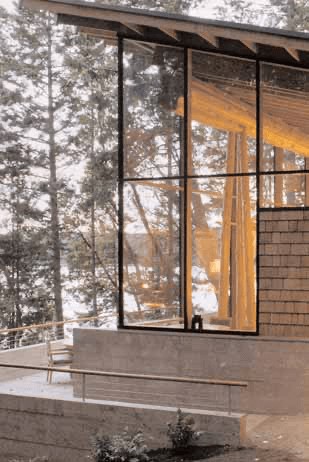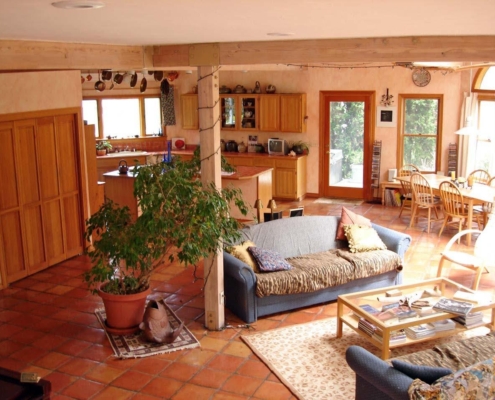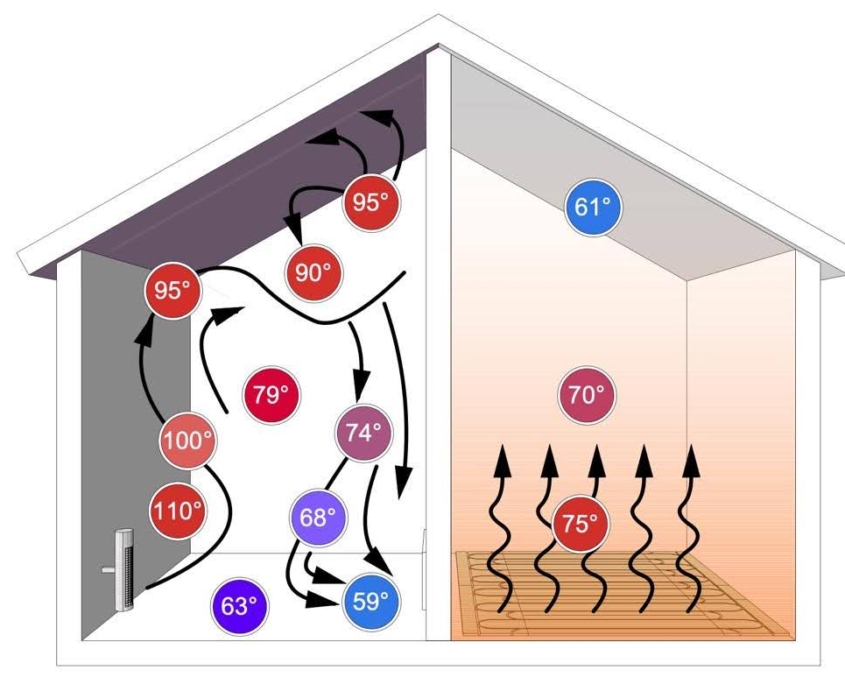Explaining the Incomparable Comfort of Radiant Heat
“You Can Feel It”: The Unspoken Comfort of Radiant Heat
“It is not warm air that makes you comfortable, but warm everything.” — James Cutler, Faia
“You can feel it the moment you walk into a room.” — Hilary Mackenzie, AIA
“Tell them it’s like the sun indoors.” — John Fantauzzi, Industry Innovator
More than 20 years ago I had the privilege of interviewing two well-known West Coast architects about their choice of radiant heating for their award-winning custom projects. Each had evolved their own vocabulary around the distinctive comfort of radiant heat, a comfort best explained by the concept of mean radiant temperature.
“You can feel it,” explains architect Hillary Mackenzie. “I have always tried to make ever better houses and buildings for my clients, and the quiet, even heat of radiant floors fits that goal. I have never had a client who didn’t love it… the comfort has a feel-good quality that is hard to describe in words, but you can feel it the moment you walk in the room.” ….So rather than simply describing the advantage of radiant heat, I recommend taking potential clients to a radiant floor-heated home, and let them feel it.
Nationally renowned architect James Cutler went beyond description of the heat itself, to explain why you feel that special quality in homes heated by hydronic radiant floors. He explained that about 98% of a home’s warmth is inherent in the mass of objects filling the interior space and radiating from surfaces, while only 2% typically comes from the heat capacity of air itself: “It is not warm air that makes you feel comfortable, but warm everything.” Cutler also appreciated that the lack of obtrusive duct work allowed him to concentrate on the bones of a structure.

Photo Credit Art Grice Courtesy of Cutler Anderson Architects
The idea that with radiantly heated interiors, “the warm everything” is what makes you so comfortable is technically understood in the industry via the concept of Mean Radiant Temperature or MRT.
I used to say, “Premium homes deserve premium heat.” And then I’d explain MRT.
Mean Radiant Temperature refers to the average temperature of all the surfaces surrounding you, including walls, windows, floors, and ceilings, even cabinetry. It represents the combined effect of radiant heat coming from all these surfaces, all contributing to a person’s perception of comfort, whether warmth or coolness. Unlike air temperature (the temperature of the air around a person), MRT represents the radiant energy exchange between a person and surrounding surfaces.
Research on MRT, human metabolic rates, and comfort, has shown that—in most cases—people in a radiantly heated home are comfortable at lower air temperatures due to the higher average surface temperature near their bodies. Typically, in a forced air home, convection drives uneven air temperatures (heat rising, for instance), which results in uneven surface temperatures: the higher parts of a room are significantly hotter, whereas in a radiant floor heated home the heat begins beneath your feet and emanates everywhere.
In calculating MRT, it is typical to take into account the surface temperatures of various surfaces within the line of sight of the person, as well as the distance from these surfaces and their respective emissivity (how well they radiate heat). Clearly, these are not intuitive calculations, but they are of consequence: the results can be felt! Since the 3 dimensional computations are very complex it is hard to represent in a drawing. But it has been well confirmed with finite element analysis and thermal imaging.
Mean Radiant Temperature, Comfort and Energy Efficiency
There is a strong relationship between Mean Radiant Temperature and comfort in radiant floor heated homes, since most of the heat is transferred directly to a person, metabolic research has also shown that in a radiantly heated home, if the MRT is below 64°-68°F, a person will likely feel cold. If you are aiming for a comfortable space, you would usually want to keep the MRT around 72°-75°F for most people, which aligns with a neutral metabolic comfort zone for indoor settings. The gift of radiant floor heating is that, due to the average surface temperatures at body level being warm.
Because of MRT most people feel comfortable at a lower air temperature than with forced air heat because of all the warm surfaces radiating heat. In a radiant heated room, the ideal condition for comfort occurs when the MRT is balanced so that there is not a big difference between what a person feels from the surrounding surfaces, and the ideal metabolic comfort ranges referenced above. The air temperature can be lower, and people will still be comfortable, as long as the MRT is higher and more consistent (steady), which is usually the case.
So maintaining a lower air temperature (than a conventional forced air system requires) saves energy, aided by the small circulating pumps required for hydronic radiant heat, and the inherent efficiencies of using the denser medium of water, versus air, to transfer heat. Forced air systems usually involve significant duct losses, and require much more fan energy to blow compressible air through big ducts.
Think How the Sun Works
My friend John Fantauzzi—an early proponent of radiant heat and colleague in the Original Radiant Panel Association—suggested we tell potential clients: “Tell them it’s like the sun indoors.” When I was a radiant floor heating contractor, I hadn’t used such a brilliantly simple image, but did tell potential customers to do a similar thought experiment: “Imagine you’re basking on a warm beach on a sunny day, all that sand and air warmed by the radiant heat from the sun.” Or, more personally, I would recount my experience as a professor at the University of New Mexico in Albuquerque:
In winter, our nights would often go down to 25°F then climb to 40°F by mid day. On the south side of the building where I taught, there was a courtyard between my building and a reservoir that had a high enough wall to protect the courtyard from the wind, but still allowed direct sunlight. That south-facing adobe-colored wall absorbed solar energy, its warmth radiating into my back as I sat in front of it, while the sun itself sent its radiant rays to warm my front side, too. I discovered that in this space that was radiantly heated from the sun, I could be comfortable on a 40° morning in a t-shirt!
Later, when I moved to the drearier winters in the Puget Sound, I was determined to bring some of that radiant sunlight with me. I built a house sited with southern exposure, with radiant floor heating that was exceptionally warm and comfortable. Our radiantly heated floors made us feel we’d brought some of the New Mexico sun north with us.


In this home in the winter, on a cold day the radiant floor might be 78°F, but because the surfaces were all at a higher temperature than air temperature, we were almost always comfortable at 67°F-68°F air temperature in shorts and a T shirt.
There are many graphics (like the one shown below) that illustrate the how air temperature in a radiantly heated home is distributed significantly differently than that in most forced air interiors. These drawings make a good argument for the efficiency of radiant floor heating, and show the more even temperatures common with radiant heat, but they don’t explain it the way the concept of Mean Radiant Temperature does.

In a radiantly heated home, Mean Radiant Temperature is what determines thermal comfort because it reflects the heat exchanged from surrounding surfaces to a person. Since this is a dynamic process that takes into account the radiant energy coming from every surface, in every direction, it is best felt and understood as a large, even, low- temperature surface which, unlike forced air, has an even lower temperature profile. It is incredibly quiet, saves energy, and perhaps best of all, it’s incredibly comfortable.

ABOUT THE AUTHOR
Hoyt Corbett
Partner, Warm Brothers Inc.
Hoyt has been involved with hydronic heating since the early 1990’s and developed and sold a national brand of radiant floor heating that was acquired by Uponor. Subsequently, Hoyt was Associate Director of the Radiant Panel Association, the industry trade group.
He’s produced extensive technical writing on radiant floor heating, writing several major national hydronic vendor’s radiant heating design and installation manuals as well as founding and publishing The Radiant Flooring Guide.
Call Hoyt at 206-369-1458, 8am to 5pm central time
or
email him at: hoyt.corbett@warmbrothersinc.com